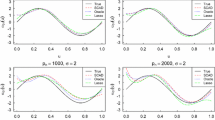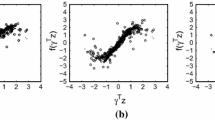Abstract
In this paper, we consider the problem of simultaneous variable selection and estimation for varying-coefficient partially linear models in a “small \(n\), large \(p\)” setting, when the number of coefficients in the linear part diverges with sample size while the number of varying coefficients is fixed. Similar problem has been considered in Lam and Fan (Ann Stat 36(5):2232–2260, 2008) based on kernel estimates for the nonparametric part, in which no variable selection was investigated besides that \(p\) was assume to be smaller than \(n\). Here we use polynomial spline to approximate the nonparametric coefficients which is more computationally expedient, demonstrate the convergence rates as well as asymptotic normality of the linear coefficients, and further present the oracle property of the SCAD-penalized estimator which works for \(p\) almost as large as \(\exp \{n^{1/2}\}\) under mild assumptions. Monte Carlo studies and real data analysis are presented to demonstrate the finite sample behavior of the proposed estimator. Our theoretical and empirical investigations are actually carried out for the generalized varying-coefficient partially linear models, including both Gaussian data and binary data as special cases.





Similar content being viewed by others
References
Cai Z, Fan J, Li R (2000) Efficient estimation and inferences for varying-coefficient models. J Am Stat Assoc 95(451):941–956
Chiang CT, Rice JA, Wu C (2001) Smoothing spline estimation for varying coefficient models with repeatedly measured dependent variables. J Am Stat Assoc 96(454):605–619
Chiaretti S, Li X, Gentleman R, Vitale A, Vignetti M, Mandelli F, Ritz J, Foa R (2004) Gene expression profile of adult T-cell acute lymphocytic leukemia identifies distinct subsets of patients with different response to therapy and survival. Blood 103(7):2771–2778
De Boor C (2001) A practical guide to splines. Springer, New York, rev. edition (2001)
Eubank RL, Huang C, Maldonado YM, Wang N, Wang S, Buchanan RJ (2004) Smoothing spline estimation in varying-coefficient models. J R Stat Soc Ser B Stat Methodol 66:653–667
Fan J, Li R (2001) Variable selection via nonconcave penalized likelihood and its oracle properties. J Am Stat Assoc 96(456):1348–1360
Fan J, Lv J (2011) Nonconcave penalized likelihood with NP-dimensionality. IEEE Trans Inf Theory 57:5467–5484
Fan J, Peng H (2004) Nonconcave penalized likelihood with a diverging number of parameters. Ann Stat 32(3):928–961
Fan J, Zhang W (1999) Statistical estimation in varying coefficient models. Ann Stat 27(5):1491–1518
Fan J, Zhang J (2000) Two-step estimation of functional linear models with applications to longitudinal data. J R Stat Soc Ser B Stat Methodol 62:303–322
Fan J, Feng Y, Song R (2011) Nonparametric independence screening in sparse ultra-high-dimensional additive models. J Am Stat Assoc 106:544–557
Frank I, Friedman J (1993) A statistical view of some chemometrics regression tools. Technometrics 35: 109–135
Hastie T, Tibshirani R (1993) Varying-coefficient models. J R Stat Soc Ser B Methodol 55(4):757–796
Huang JZ, Wu C, Zhou L (2002) Varying-coefficient models and basis function approximations for the analysis of repeated measurements. Biometrika 89(1):111–128
Huang JZ, Wu C, Zhou L (2004) Polynomial spline estimation and inference for varying coefficient models with longitudinal data. Stat Sin 14(3):763–788
Huang J, Horowitz J, Ma S (2008) Asymptotic properties of bridge estimators in sparse high-dimensional regression models. Ann Stat 36(2):587–613
Huang J, Horowitz J, Wei F (2010) Variable selection in nonparametric additive models. Ann Stat 38(4):2282–2313
Kim Y, Choi H, Oh H (2008) Smoothly clipped absolute deviation on high dimensions. J Am Stat Assoc 103(484):1665–1673
Lam C, Fan J (2008) Profile-kernel likelihood inference with diverging number of parameters. Ann Stat 36(5):2232–2260
Li R, Liang H (2008) Variable selection in semiparametric regression modeling. Ann Stat 36(1):261–286
McCullagh P, Nelder JA (1989) Generalized linear models, 2nd edn. Chapman and Hall, London, New York
Tibshirani R (1996) Regression shrinkage and selection via the Lasso. J R Stat Soc Ser B Methodol 58(1):267–288
van der Geer SA (2000) Applications of empirical process theory. Cambridge University Press, Cambridge
Wang H, Xia Y (2009) Shrinkage estimation of the varying coefficient model. J Am Stat Assoc 104(486):747–757
Wang L, Li H, Huang JZ (2008) Variable selection in nonparametric varying-coefficient models for analysis of repeated measurements. J Am Stat Assoc 103(484):1556–1569
Wang L, Wu Y, Li R (2012) Quantile regression for analyzing heterogeneity in ultra-high dimension. J Am Stat Assoc 107(497):214–222
Wang L, Liu X, Liang H, Carroll R (2011) Estimation and variable selection for generalized additive partially linear models. Ann Stat 39:1827–1851
Wei F, Huang J, Li H (2011) Variable selection in high-dimensional varying-coefficient models. Stat Sin 21:1515–1540
Xie H, Huang J (2009) SCAD-penalized regression in high-dimensional partially linear models. Ann Stat 37(2):673–696
Yuan M, Lin Y (2007) On the non-negative garrotte estimator. J R Stat Soc Ser B Stat Methodol 69:143–161
Zhang C (2010) Nearly unbiased variable selection under minimax concave penalty. Ann Stat 38(2):894–942
Zou H (2006) The adaptive lasso and its oracle properties. J Am Stat Assoc 101(476):1418–1429
Zou H, Li R (2008) One-step sparse estimates in nonconcave penalized likelihood models. Ann Stat 36(4):1509–1533
Acknowledgments
The authors sincerely thank the two referees for their insightful comments and suggestions that have lead to improvements on the original manuscript. The research of Heng Lian is supported by Singapore MOE Tier 1 Grant.
Author information
Authors and Affiliations
Corresponding author
Appendix
Appendix
Proof of Theorem 1
1 Let \(X_i^{(1)}=(X_{i1},\ldots ,X_{is})^T\) be the subvector of \(X_i\) associated with nonzero coefficients, and correspondingly let \(\beta _0^{(1)}=(\beta _{01},\ldots ,\beta _{0s})^T\). Since Theorem 1 only considers the oracle estimator, we will omit the superscript \((.)^{(1)}\) in the following. Let \(a_0^*=(a_0^T,\beta _0^T)^T\), \(\hat{a}^*=(\hat{a}^{oT},\hat{\beta }^{oT})^T\), and note that \(U_i=(Z_i^T,X_i^T)^T\). Since \(\hat{a}^*=(\hat{a}^o,\hat{\beta }^o)\) minimizes
with respect to \(a^*\), \(\hat{a}^*\) satisfies the first-order condition
Using Taylor expansion at \(U_i^Ta_0^*\) for the left hand side of (9), we get
where \(z_i\) lies between \(U_i^Ta_0^*\) and \(U_i^T\hat{a}^*\).
First, note that the eigenvalues of \(\sum _i q_2(z_i,Y_i)U_iU_i^T\) are of order \(n\). Furthermore, we will show that
and thus (10) implies \(\Vert \hat{a}^*-a_0^*\Vert =O_P(\sqrt{(K+s)/n}+1/K^{d})\), which in turn immediately implies \(\sum _j\Vert \hat{\alpha }_j-a_{0j}^TB\Vert +\Vert \hat{\beta }^o-\beta _0\Vert =O_P(\sqrt{(K+s)/n}+1/K^d)\).
Now what is left is to demonstrate (11). Using the notation
and
\(\Vert \sum _i{q}_1(U_ia_0^*,Y)^TU_i\Vert \) can be written as \(\Vert \mathbf q _1(U^Ta_0^*,Y)^TU\Vert \). For an arbitrary \(v\in R^{qK+s}\), we have \(|\mathbf q _1(U^Ta_0^*,Y)^TUv|^2\le \Vert P_U\mathbf q _1(U^Ta_0^*,Y)\Vert ^2\cdot \Vert Uv\Vert ^2\), where \(P_U=U(U^TU)^{-1}U^T\) is a projection matrix.
Obviously \(\Vert Uv\Vert ^2=O_P(n\Vert v\Vert ^2)\). Besides, we have
where \(\mathbf m =(m_1,\ldots ,m_n)^T\) with \(m_i=W_i^T\alpha _0(T_i)+X_i^T\beta _0\). The first term is of order \(O_P(tr(P_U))=O_P(K+s)\) since \(\mathbf q _1(\mathbf m ,Y)\) has mean zero conditional on the predictors. The second term is bounded by, using Taylor expansion and (C2), \(O_P(n/K^{2d})\).
\(\square \)
Proof of Theorem 2
2 As in the previous theorem, we still omit the superscript \((1)\) here. Let \(\tilde{\mathcal{G }}\) be the subset of \(\mathcal G \) where \(h_j\)’s are constrained to be polynomial splines. The functions \(\Gamma _{j}\in \mathcal G \) can be approximated by \(\hat{\Gamma }_{j}\in \tilde{\mathcal{G }}\) with \(\Vert \hat{\Gamma }_{j}-\Gamma _{j}\Vert _\infty =O(K^{-d})\). Let \(\hat{\Gamma }=(\hat{\Gamma }_1,\ldots ,\hat{\Gamma }_s)^T\). Consider the following functional
where \(\hat{m}_i=Z_i^T\hat{a}^o+X_i^T\hat{\beta }^o\) and \(\nu =(\nu _1,\ldots ,\nu _s)^T\). Obviously, the above functional is minimized by \(\nu =0\) which leads to the first-order condition
Since
where \(q_2(.,Y_i)\) is evaluated at some point between \(\hat{m}_i\) and \(m_i\), we can replace \(\hat{\Gamma }\) in (12) by \(\Gamma \) to get
Now we have
Using Theorem 1, we have \(\sum _iq_2(m_{i},Y_i)(Z_i^T\hat{a}^o-W_i^T\alpha (T_i))(X_i-\Gamma (W_i,T_i))=o_p(\sqrt{n})\) and \(\sum _iq_2^{\prime }(.,Y_i)(\hat{m}_i-m_{i})^2(X_i-\Gamma (W_i,T_i))=o_p(\sqrt{n})\). Also, it is easy to see that
by central limit theorem, and that
and asymptotic normality of \(\hat{\beta }\) follows. \(\square \)
The proof of Theorem 3 is based on the following proposition, which is a direct extension of Theorem 1 in Fan and Lv (2011) to the case of quasi-likelihood (but specialized to the SCAD penalty). A similar second-order sufficiency was also used in Kim et al. (2008) in linear models (see the proof of their Theorem 1). Thus the proof of the following proposition is omitted.
Proposition 1
\((a^T,\beta ^T)\in R^{qK+p}\) is a local minimizer of the SCAD-penalized quasi-likelihood (3) if
where \(Z_{ij}=(W_{ij}B_{1}(T_{i}),\ldots ,W_{ij}B_{K}(T_i))^T\in R^K\).
Proof of Theorem 3
3 We will show that \((\hat{a}^T,\hat{\beta }^T)=(\hat{a}^o, \hat{\beta }^{(1)}=\hat{\beta }^o,\hat{\beta }^{(2)}=0)\) satisfies (14)–(16). This will immediately imply all the results stated in Theorem 3.
Denote \(\hat{a}^*=(\hat{a}^o, \hat{\beta }^{(1)})\) and \(a_0^*=(a_0,\beta _0^{(1)})\). It trivially holds that \(\sum _iq_1(Z_i^T\hat{a}^o+X_i^T\hat{\beta }^o,Y_i)Z_{ij}=0, j=1,\ldots ,q\) and \(\sum _iq_1(Z_i^T\hat{a}^o+X_i^T\hat{\beta }^o,Y_i)X_{ij}=0, j=1,\ldots ,s\) by the definition of \(\hat{a}^o,\hat{\beta }^o\). Furthermore, note that \(|\hat{\beta }_j|\ge a\lambda \) is implied by
and both equations above are implied by (C7) as well as Theorem 1.
For \(j=s+1,\ldots ,p\), \(|\hat{\beta }_j|< \lambda \) is trivial since \(\hat{\beta }_j=0\). Furthermore, we have
where in the last step above we used (10).
Denote \(e=(1,\ldots ,1)^T\), \(\delta _j=(X_{1j}q_1(U_1^Ta_0^*,Y_1),\ldots ,X_{nj}q_1(U_n^Ta_0^*,Y_n))^T\), and \(P=(p_{ii^{\prime }})_{n\times n}\) with \(p_{ii^{\prime }}\!=\!q_2(z_i,Y_i)U_i^T(\sum _{i^{\prime }}q_2(z_{i^{\prime }},Y_{i^{\prime }})U_{i^{\prime }}U_{i^{\prime }}^T)^{-1}U_{i^{\prime }}\). By Taylor expansion, we can write \(\delta _j=\epsilon _j+\gamma _j\) with \(\epsilon _j=(X_{1j}q_1(m_{1},Y_1),\ldots ,X_{nj}q_1(m_{n},Y_n))^T\) and \(\gamma _j=(X_{1j}q_2(.,Y_1)(U_1^Ta_0^*-m_{1}),\ldots ,X_{nj}q_2(.,Y_n)(U_n^Ta_0^*-m_{n}))^T\), where \(m_{i}=\sum _j\alpha _{0j}(X_{ij})\) and \(q_2(.,Y_i)\) is evaluated at some point between \(U_i^Ta_0^*\) and \(m_{i}\).
Using these notations, (17) can be written as \(e^T(I-P)\delta _j=e^T(I-P)\epsilon _j+e^T(I-P)\gamma _j\). In Lemma 1 below we show
and
Thus (C5) implies \(\max _{j\ge s+1}\) \(|\sum _iq_1(U_i^T\hat{a}^*,Y_i)X_{ij}|=o_P(n\lambda )\) which completes the proof. \(\square \)
Lemma 1
Here we show that
and
Proof of Lemma 1
1 First, it is easy to see that all the eigenvalues of the matrix \(P\) are bounded by \(1\) (in fact the eigenvalue is either 0 or 1), and thus \(\Vert e^T(I-P)\Vert \le \sqrt{n}\). Write the vector \(e^T(I-P)\) as \(b=(b_1,\ldots ,b_n)^T\) and then \(e^T(I-P)\epsilon _j\) is written as \(\sum _ib_i\epsilon _{ij}\) with \(\epsilon _{ij}=X_{ij}q_1(m_{i},Y_i)\). By assumption (C6), we have
and thus
using that \(\Vert b\Vert ^2\le n\). Thus by Theorem 8.9 (Bernstein’s inequality) in van der Geer (2000), together with a simple union bound, we get
Thus if \(c=C\sqrt{n}\log (p\vee n)\) for sufficiently large \(C>0\), the above probability converges to zero, showing the validity of (18).
For the proof of (19), we only need to note that \(|e^T(I-P)\gamma _j|\le \Vert b\Vert \cdot \Vert \gamma _j\Vert =O_P(\sqrt{n}\cdot \sqrt{n}K^{-d})\) by (C2).
Rights and permissions
About this article
Cite this article
Hong, Z., Hu, Y. & Lian, H. Variable selection for high-dimensional varying coefficient partially linear models via nonconcave penalty. Metrika 76, 887–908 (2013). https://doi.org/10.1007/s00184-012-0422-8
Received:
Published:
Issue Date:
DOI: https://doi.org/10.1007/s00184-012-0422-8




